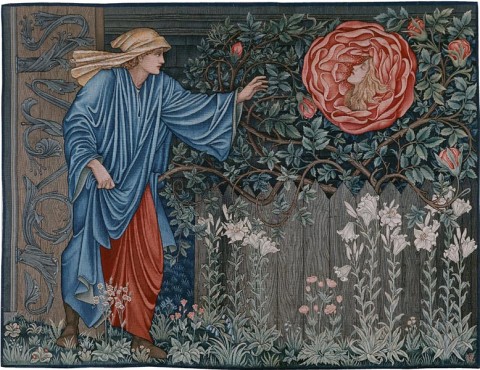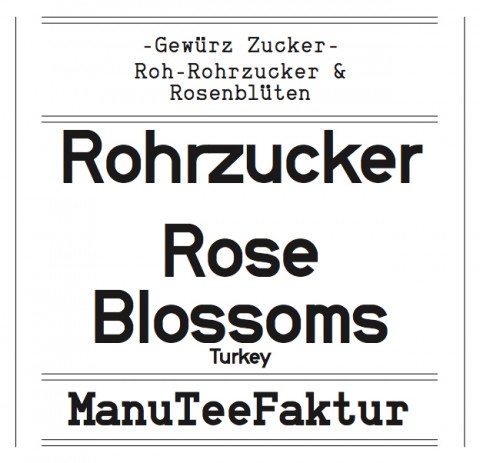Cane sugar & rose blossoms
From: €6.50
CANE SUGAR & ROSE BLOSSOMS
SACCHARUM OFFICINARUM & ROSA GALLICA
ROSA GALLICA
Rosa gallica (Gallic rose, French rose, or rose of Provins, German: Essig-Rose means vinigar rose) a species of the genus roses (Rosa) within the rose family (Rosaceae). It is the robust wild rose that has been cultivated for many centuries and from wich of our modern garden roses are descended; Rosa Gallica is considered to be one of the Old Roses.
Rosa Gallica is native to southern and central Europe eastwards to Turkey and the Caucasus. Since ancient times its petals where used in tea by pharmacists. The extract of the flowers operate astringent and is was used for healing the mouth and throat, to gargle, and for the treatment of not healing wounds. Rosa Gallica has been cultivated in plantations by the Romans - in addition to her fragrance and her ornament for gardens - as a medicinal plant and for manufactureing of rose oil, rose water, rose vinegar. After the fall of the Roman Empire Rosa Gallica was cultivated as a medicinal plant in monastery gardens.
ROSACEAE
A rose is a rose is a rose.
Queen and courtesan, ethereal beauty and fierce pirate, wild daughter of Venus and sacred companion of the Mother of God - the rose is, according to Rilke “pure contradiction”. She is delicate as the finest porcelain, and yet its thorns can teach one to fear. She is graceful and bursting with strength vital, it is fast fleeting and so untamable rich in species that occasionally Goethe called his favorite plants “die Lüderlichen“.
In Greek mythology: Aphrodite, the Greek goddess of love, beauty, pleasure, and procreation arose from the sea foam (aphros) and where the foam fell from her body to the ground white roses grew. Later in her life when she runs to help her wounded lover Adonis she catches her flesh on the thorns of the white rose bush. Her blood falling on the bush turns the roses red.
Aphrodite display the dual nature of love: purity and innocence represented by white roses; desire and sexual gratification by red ones. Eros, son of Aphrodite and God of sexual desire, is frequently depicted wearing a wreath of roses. When Aphrodite presented a rose to her son Eros, god of love, the rose became a symbol of love and desire. Eros gave the rose to Harpocrates, the god of silence, to induce him not to gossip about his mother’s amorous indiscretions. Thus the rose also became a symbol of silence and secrecy…
In the middle ages a rose was suspended from the ceiling of a council chamber, pledging all present to secrecy, or sub rosa (“under the rose”).
A Persian tale tells how a nightingale fell in love with a beautiful white rose and flew blindly towards its fragrance. Pierced by a thorn, the nightingale’s blood flowed over the white petals, turning them red.
When Christians adopted the rose as a symbol, it still carried connections with ancient mother goddesses. The flower became associated with Mary, the mother of Christ, who was sometimes addressed as the Mystic or Holy Rose. In time, the rose took on additional meanings in Christian symbolism. Red roses came to represent the blood shed by the martyrs who died for their faith; white ones stood for innocence and purity. One Christian legend says that roses originally had no thorns. But after the sin of Adam and Eve—for which they were driven out of the Garden of Eden—the rose grew thorns to remind people that they no longer lived ill a state of perfection.
Read more: http://www.mythencyclopedia.com/Fi-Go/Flowers-in-Mythology.html#ixzz3HWamkqVd
In Christian tradition, the rose is said to have first appeared in Bethlehem near the stable where Jesus Christ was born.
http://en.wikipedia.org/wiki/Rosa_gallica
Foto:
http://kultur-online.net/node/9494
SUGAR CANE
SACCHARUM OFFICINARUM
Sugarcane, or Sugar cane, is any of six to 37 species of tall perennial true grasses of the genus Saccharum, tribe Andropogoneae, native to the warm temperate to tropical regions of South Asia. The world demand for sugar is the primary driver of sugarcane agriculture.
In India, between the sixth and fourth centuries BC, the Persians, followed by the Greeks, discovered the famous “reeds that produce honey without bees”. They adopted and then spread sugar and sugarcane agriculture. A few merchants began to trade in sugar—a luxury and an expensive spice until the 18th century. Before the 18th century, cultivation of sugar cane was largely confined to India. Sugarcane plantations, like cotton farms, were a major driver of large human migrations in the 19th and early 20th century, influencing the ethnic mix, political conflicts and cultural evolution of various Caribbean, South American, Indian Ocean and Pacific island nations.
Crystallized sugar was reported 5,000 years before the present in the Indus Valley Civilization, located in modern-day Pakistan and north India.Around the eighth century AD, Arab traders introduced sugar from South Asia to the other parts of the Abbasid Caliphate in the Mediterranean, Mesopotamia, Egypt, North Africa, and Andalusia. By the 10th century, sources state that there was no village in Mesopotamia that did not grow sugarcane. It was among the early crops brought to the Americas by the Andalusians from their fields in the Canary Islands, and the Portuguese from their fields in the Madeira Island.
Boiling houses in the 17th through 19th centuries converted sugarcane juice into raw sugar. …
http://en.wikipedia.org/wiki/Sugar_cane
Foto:
http://commons.wikimedia.org/wiki/File:Cut_sugarcane.jpg
http://www.google.de/imgres?imgurl=http://upload.wikimedia.org/wikipedia/commons/thumb/a/a0/Saccharum_officinarum_Blanco1.18.jpg/160px-Saccharum_officinarum_Blanco1.18.jpg&imgrefurl=http://sk.wikipedia.org/wiki/Cukrov%25C3%25A1_trstina&h=243&w=160&sz=10&tbnid=zz6yA5-bMBjTvM:&tbnh=82&tbnw=54&zoom=1&usg=__30KDOxTCrMedzs8Lu7wjgRPkPUA=&docid=Ijc7zJA5YnfqtM&hl=de&sa=X&ei=02xVUZz1McfEtAbqtYDQDA&ved=0CD8Q9QEwAg&dur=333
USE IT FOR SWEETING:
- crêpe & galette
- waffles
- fruit salats
- yoghurt, cereals & muesli
- fresh baked pastries like: cakes & biscuits
- pancakes
- tea & coffee
… or just to sweeten the day!
- - - - - - - - - - - - - - - - - - - - - - - - - - - - - -
S: 200g / L: 600g
SHIPPING COSTS:
>2kg: 4,10€ Germany/8,90€ EU/15,90€ World (Zone-I)
>5kg: 6,99€ Germany/16,99€ EU(Zone-I)/29,99€ World(Zone-II)
Additional Information
| Size | Small, Medium |
|---|





